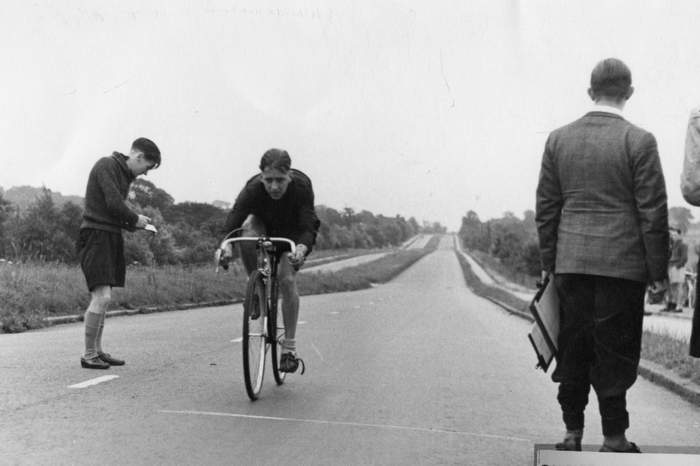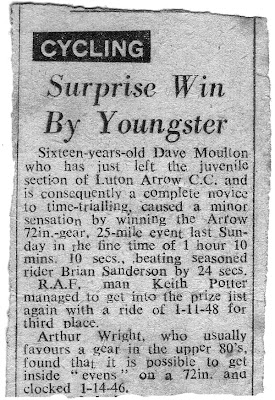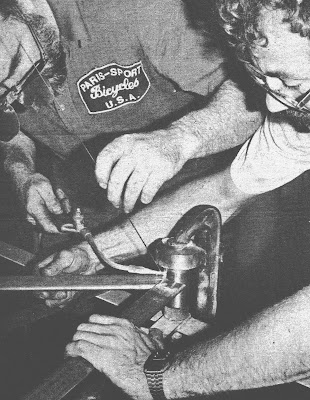1970s Time-Trial Bike
 Mon, March 17, 2008
Mon, March 17, 2008 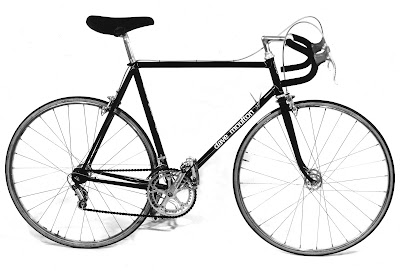 Fag paper clearances. (British slang for cigarette paper.) Meaning the rear wheel was so close to the seat tube that you could barely get a cigarette paper between the tire and the frame tube. See the picture above.
Fag paper clearances. (British slang for cigarette paper.) Meaning the rear wheel was so close to the seat tube that you could barely get a cigarette paper between the tire and the frame tube. See the picture above.
This was an extreme fashion fad in the UK during the mid 1970s especially on time trial bikes. It served no useful purpose except to make the chainstays shorter thereby saving a little weight, and making the rear triangle a little stiffer. The frames were usually built using vertical rear dropouts to achieve the close clearance.
When fads like this become fashion a framebuilder can do little but follow the latest trend, or loose business; I was no different. However, I did not follow the extremes of some framebuilders who built these frames with clearances so close you had to deflate the rear tire to get the wheel in and out. This bordered on the ridiculous.
Some built frames with extremely steep head angles so the front wheel barely cleared the down tube. This was a part of the trend I refused to follow, as it made for some very “squirrelly” bikes. The last thing a rider needs is a squirrelly time trial bike; a TT bike needs to hold a straight line.
I remember one frame (not one of mine.) brought to me for repair. The down tube and top tube were bent. My first question was, “What did you hit?” The owner replied, “Nothing, I slowed to take a corner, and the frame collapsed under me.”
When I inspected the frame the first thing I noticed was a black rubber tire mark under the down tube right where the tube folded. It became clear to me what had happened. The front wheel was so close to the down tube that when the rider applied the front brake there was enough flex that the front wheel touched the down tube.
Maybe his headset was a little loose, whatever the cause, once the front wheel touched it would have stopped the bike very quickly and the forward momentum folded the frame. I replaced the top and down tubes, making sure to make the head angle a little shallower, making for a little more front wheel clearance.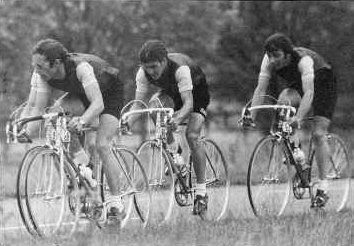 The bike pictured at the top was one I built for John Patston, an international class rider who represented Great Britain on their national team. In the above picture, John Patston is leading, followed by Paul Carbutt, and Pete Hall. (All on ‘dave moulton’ frames.)
The bike pictured at the top was one I built for John Patston, an international class rider who represented Great Britain on their national team. In the above picture, John Patston is leading, followed by Paul Carbutt, and Pete Hall. (All on ‘dave moulton’ frames.)
The forth rider Grant Thomas is obscured behind Patston. This was the British Team riding in the 1975 World Championship 100 km. Team Time Trial event.
John Patston was primarily a road rider, very strong and aggressive, often riding away from the opposition to win solo. If others stayed with him, he would usually win the finishing sprint. He was also an excellent time trialist.  I received a great deal of publicity from this particular bike. It featured in the British “Cycling” magazine. (Affectionately known by cyclists throughout the UK, as “The Comic.”)
I received a great deal of publicity from this particular bike. It featured in the British “Cycling” magazine. (Affectionately known by cyclists throughout the UK, as “The Comic.”)
I can’t remember whether the bike was built in Columbus or Reynolds tubing, but the complete bike built up with Campagnolo titanium components, weighed in a 19 lbs. Pretty light for 1977 when this was built.
The bike was also featured in “The Penguin Book of the Bicycle” published in 1978. (Left.) The same photo shown at the top was used for the title page as the book was opened. (See below.)
My name was airbrushed from the picture, as were the spokes from the wheels to make room for the title text. However the same picture appeared again later in the book, this time with my name intact.The frame was painted black and had gold pin striping on the edges of the lugs. It also had John’s initials “JP” painted in gold on the seatstay caps. Cycling magazine drew an interesting parallel to this, one that I had not realized when I chose that particular color scheme.
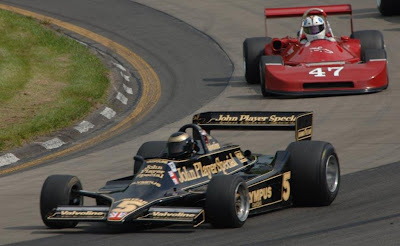 The British tobacco giant “John Player,” also with initials JP, sponsored a Grand Prix racing team at that time. The cars built by Lotus were painted black with gold lettering.
The British tobacco giant “John Player,” also with initials JP, sponsored a Grand Prix racing team at that time. The cars built by Lotus were painted black with gold lettering.
My thanks to Lance Woodman for reminding me of this bike.
 Dave Moulton | Comments Off |
Dave Moulton | Comments Off | 
















